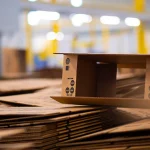Can data centers be energy and environmentally sustainable?
There has been a lot of excitement generated by the news that Portugal is developing the largest data centre hub in Europe. Called Start Campus, it promises to deliver AI-Scale data centres with innovative cooling features running on 100% renewable energy and zero water waste.
Which is why this year’s 6th Ireland-Portugal Business Network’s panel conversation about Sustainable AI-Scale Data Centres featuring Start Campus Sustainability Manager, India Branquinho de Oliveria’s talk ‘Delivering AI-Scale Data Centres’ was timely and fascinating.
Start Campus is developing the Sines DC project in Portugal, a 1.2GW data centre campus at Sines, one-hour’s drive from Lisbon, creating Europe’s largest and most sustainable data ecosystem with market-leading global connectivity.
Sines DC promises to provide maximum optionality for customers with powered shell, turn-key and build-to-suit solutions. The company’s advanced customer offerings are AI-ready and address the future needs of the industry by integrating liquid cooling technologies into its flexible and scalable design.
With a total combined investment value of €8.5Bn, the project will use 100% renewable energy and targets an industry-leading PUE (Power Usage Effectiveness) of 1.1 and a WUE (Water Usage Effectiveness) of 0 by harnessing the cooling power of the ocean. Start Campus will be Net Zero by 2030.
There are two investor companies behind it – the global investment firm Davidson Kempner and independent infrastructure investment firm Pioneer Point Partners.
The project went largely under the radar for the general population in Portugal until it got caught up in some controversy, not of its own making, back in December, 2023 making international headlines.
The Portuguese public prosecutor’s office published an official communication announcing searches at the homes and offices of several high-ranking people, including the official residence of the then Prime Minister, António Costa, to investigate possible corrupt practices related to several investments of national importance, including the Start Campus project.
The allegations all came to nothing, although it resulted in the decision by the Prime Minister to resign and, inevitably, the fall of the government and snap elections early the following year.
But with these teething problems out of the way, the first data centre unit was ready for operation in October, 2024 and work is just about to begin on a second data centre building this summer, probably from July.
Energy guzzling
Giving some background context, Kayleigh Anne Myles, ESG & Sustainability Lead at Lawler Sustainability (winner of this year’s IPBN Success Award) reminded that data centres supported the digital economy and everyone who has a mobile phone or laptop should know that that data would inevitably be stored ‘in cloud’ meaning a data centre.
Nevertheless, concerns have been growing regarding the ‘energy share’, particularly in Ireland where 21% of electrical energy consumption is currently consumed by data centres. In Portugal that figure may have less environmental impact since there are less data centres and 70% of the country’s energy is generated from renewable sources.
Critics argue that AI and data centers are not sustainable since data centres are high energy intensive facilities due to the high power requirements of the computing equipment and the infrastructure needed to support the computing equipment, in particular its cooling systems, and in this respect are similar to industrial facilities in terms of energy consumption rather than commercial or service buildings.
And Portugal’s data centre development is still at an early stage relative to other countries like Ireland or the UK, and the question was how could Ireland learn from Portugal and vice-versa in managing data centre energy consumption.
Start Campus – leading by example
India Branquinho de Oliveira explained that by creating the first data centre campus in Portugal, Start Campus was “trying to lead by example” by investing in renewable energy but admitted that the data centers industry was “quite scary” since many don’t fully understand what they could mean for the development of companies and the country.
However, Start Campus will be the first data centre in Portugal power by 100% renewable energy and this means that the design which powers and cools the infrastructure by using infrastructures already in Sines, cools down the DC through zero water usage.
“It’s now only about tapping into the massive investment in renewable energy that is being made in Portugal (By 2030 Portugal will have over 90% of its grid energy powered from renewable sources) and using sea water without really using but recycling it (Zero WE) to put a benchmark on what sustainability targets are for the industry”, she said.
India points out that sustainability is also about investing in the community and showcasing the impact for local opportunities.
Sines has a lot of industrial sites with growing industries and the demands of this local and small community is also growing. “The local population is very wary of this new DC industry and we want to allay these worries and educate and invest in giving back to the community through housing developments but also in education through partnerships with local technical schools”, she explained.
The Irish story – not enough renewable energy to meet demand
Panelist Luis Adolfo, Director of Skanstec Engineering and IPBN Executive Partner whose company offers solutions for large power users such as data centres, gave an overview of how the data centre industry is Ireland was developing.
Living in Ireland since 2005 he knows the Irish grid and energy challenges the country faces, and from a data centers point of view Ireland has the biggest presence and usage of data centres in Europe with 92 operational DCs many of which are hyperscalers specialising in delivering massive amounts of computing power and storage capacity to companies, organizations and individuals in Ireland and across the globe.
Luís said that over the last 15 years there has been a big boom in the industry, growing faster than they should have, with 21% of energy consumption used by data centres with projections of that increasing to 30% by the end of the decade.
“There is a lot that needs to be done in Ireland to ensure that we have enough energy to supply them given that data centres have grown so fast but renewable sources have not kept pace,” he said.
Ireland, he added, needed to speed up the development of renewables and attract developers to the country that could help meet this challenge.
To give some idea, there are 15 data centre projects on standby at present because of a lack of grid availability as well as planning permission issues, holding up around €8Bn of investment.
On the operational side this requires off-site manufacturing, modular building, equipment that doesn’t use SF6 gases like sulfur hexafluoride – used in the electrical industry as a gaseous dielectric medium for high-voltage sulfur hexafluoride circuit breakers, switchgears, and other electrical equipment.
In Ireland most of the data centres are city-based and Sines is an example of how Ireland can develop its data centres out of town.
“Data centres are not going anywhere, we need them for the future. They will be bigger and are power hungry and AI requires a lot of thought on how we can bring enough power to these data centres.
And here, Portugal’s leading role in Europe in developing off-shore wind farms can clearly point the way for Ireland.
Before AI a regular data centre required around 30MW of power but now this has multiplied by a factor of 10 to feed bigger servers, meaning large-scale DCs like Start Campus.
Community and social initiatives
India explained some of the community and social initiatives to offset the fears local people and environmentalists have about the project and the climate risk from taking so much energy from the grid.
“AI can actually help innovate the whole industry by itself and this means the circular economy. In Sines we are building a 1.2GW facility with AI factored in. Sines has a relatively low income community who are not necessarily going to directly benefit from this AI-scale facility.
“But we’re not building just for Portugal; we’re building for Europe, and we have to mitigate this through education and other social initiatives such as our Gamma Community Platform which invests in creating a new service of social physiotherapy at home, complementing existing services”.
The project will improve people’s quality of life, whether they are independent or in a situation of temporary or permanent dependence, through ‘functionality recovery and promotion of physical and psychological well-being’ and minimising the constraints people with mobility problems who need extra care have, either due to their physical condition and lack of proper medical supervision, or constraints on time, transport and travelling distance. The project also intends to provide a mobile application for scheduling physio sessions including video call physiotherapist services.
Funding local startups
India also outlined how every year Start Campus funds local startups that support the main pillars of its business – sustainability, innovation in education and healthcare with a €100,000 investment fund providing opportunities and funding for local startups.
It also provides funds for the Colleges for European for Data Centres Education providing education and technical know-how for those who want to work in and invest in the industry as well as digital applications in nursery teaching through Power Zero, a project from a UK-based NGO that promotes ways of how this AI and digital world can be beneficial for children and young people, and child development as a whole.
Luís shed some light on success stories involving date centres in Ireland (Ireland was a pioneer) and in Europe, particularly in Scandinavia. “In these countries the heat being generated by the servers will be reused by local communities, such as one in Denmark heating 7,000 homes at low cost.
But he also warned that Ireland could lose some opportunities in terms of investment if it didn’t “change some rules of the game” such as developing large off-shore wind farms (currently Ireland only has one) given the country’s windy west coast. “This would be a game-changer from an industry point of view and for power generation and supply in Ireland”, he concluded.










